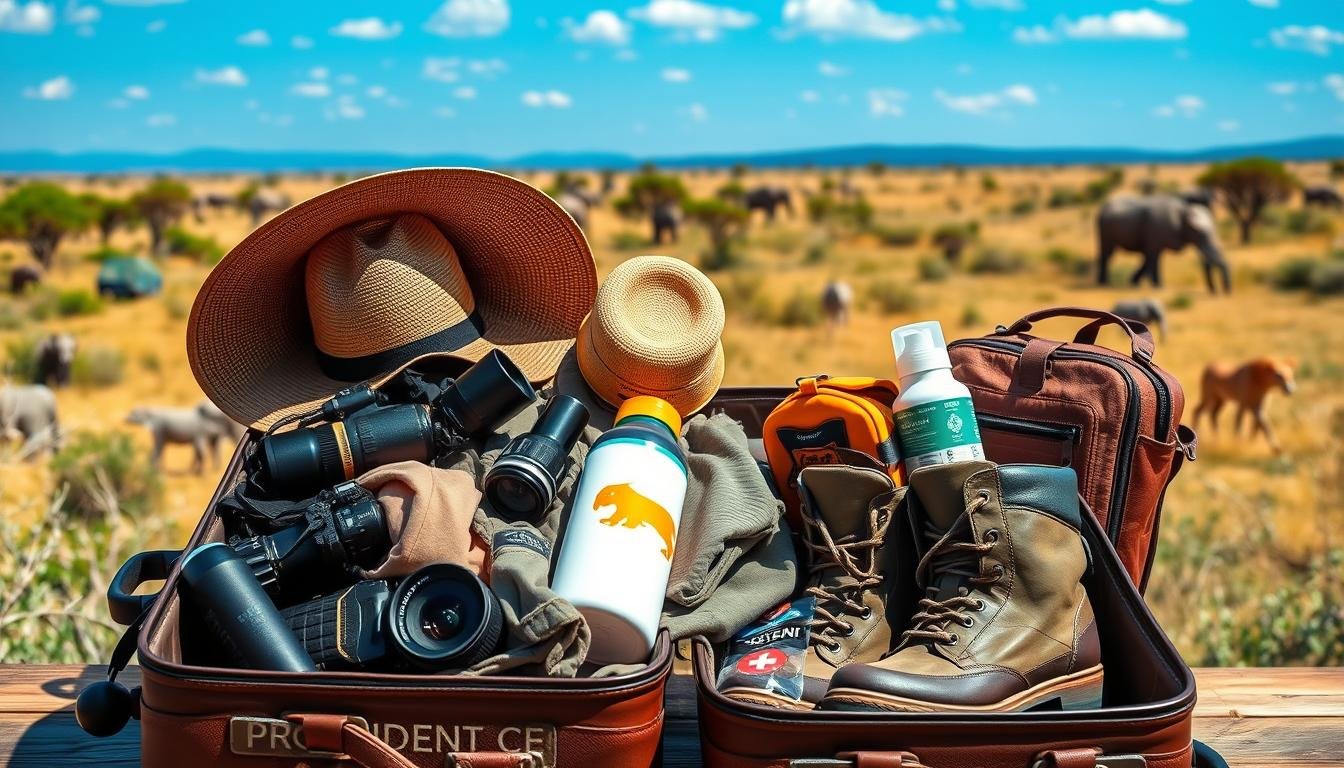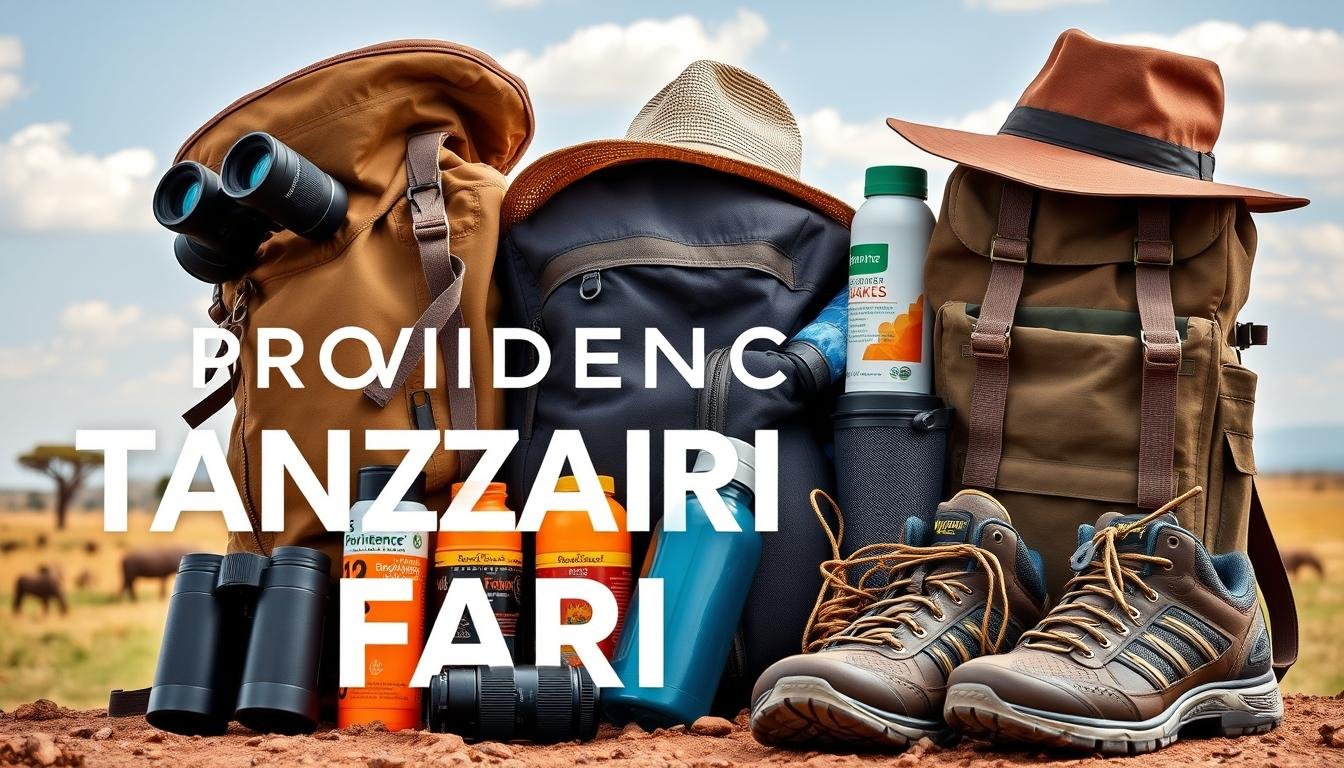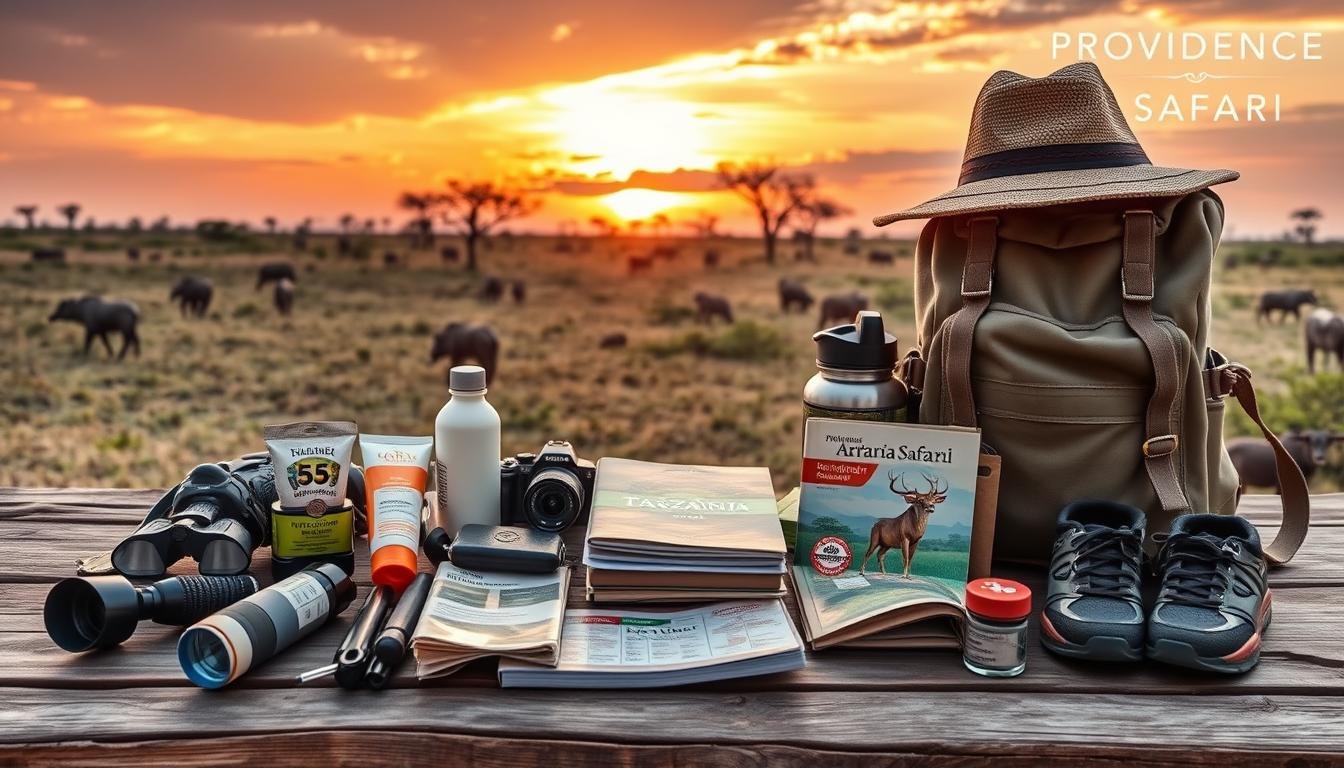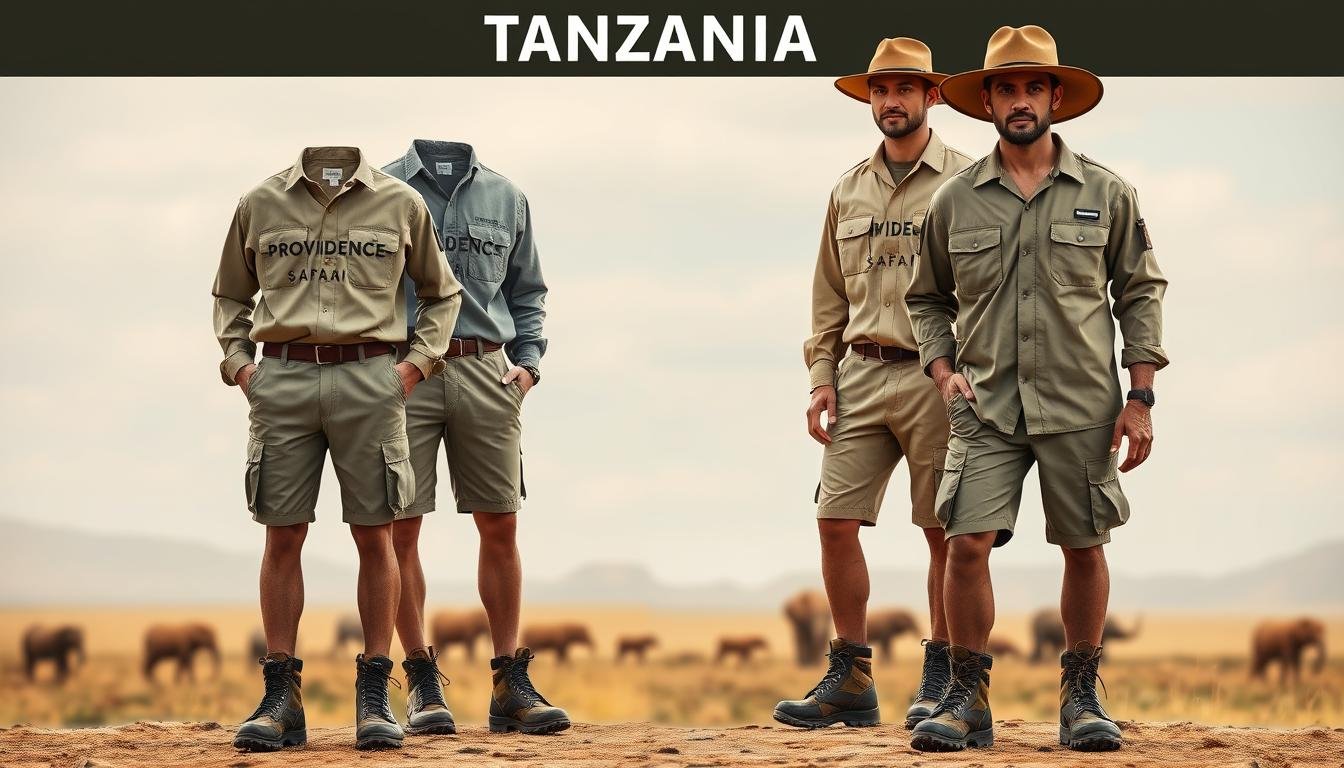Going on a safari in Tanzania is a unique adventure. You get to see the amazing African wilderness and its incredible animals. It’s important to pack the right things to enjoy your trip fully. This guide will help you know what to bring, from essential items to personal needs.
Tanzania has different landscapes, like the Serengeti and Ngorongoro Crater. Each place has its own challenges and needs special gear. Whether you’re driving yourself or going on a guided tour, our tips will make packing easier. By the end, you’ll be ready for an unforgettable Tanzanian safari.
Key Takeaways
- Learn the essential gear and equipment needed for a Tanzania safari
- Understand the unique climate and terrain to pack the right clothing and accessories
- Discover the best camera gear and accessories to capture unforgettable moments
- Prepare for your personal needs, from health essentials to travel documents
- Explore the different types of accommodation and amenities to expect on a Tanzania safari
Understanding Tanzania’s Safari Environment
Going on a Tanzania safari is an exciting journey. But, knowing the environment you’ll see is crucial for a great trip. Let’s explore the climate, terrain, and wildlife you’ll find during your Tanzania safari gear and Tanzania safari supplies planning.
The Climate: What to Expect
Tanzania’s weather is mostly tropical, with wet and dry seasons. The dry season, from June to October, is hot and sunny. It’s perfect for planning your Tanzania safari gear and Tanzania safari supplies.
The wet season, from November to May, brings more rain, especially in the north. This can affect how easy it is to see wildlife and get around.
Terrain and Wildlife
Tanzania has vast savannas, lush forests, and high mountains. This landscape is home to many animals, including the “Big Five” (lions, leopards, rhinos, elephants, and buffalo). You’ll also see giraffes, zebras, wildebeests, and many bird species.
Seasons and Timing
The best time for a Tanzania safari depends on what you want to see. The dry season, from June to October, is best for spotting animals. They gather near water, making them easier to see.
The wet season, from November to May, offers a unique experience. You can see the wildebeest migration and enjoy green landscapes.
“Tanzania’s diverse landscape and wildlife are truly awe-inspiring. Understanding the environment you’ll be exploring is essential for packing the right Tanzania safari gear and Tanzania safari supplies.”
Essential Safari Gear
Packing the right gear is key for a great Tanzania safari adventure. You’ll need the best Tanzania safari clothing, comfy footwear, and essential accessories. We’ll show you what to pack to be ready for your wild adventure.
Clothing: What to Wear
For Tanzania safari clothing, choose items that are versatile and practical. Go for light, breathable fabrics that can be layered. Colors like khaki, olive, and beige are best because they blend with nature and don’t scare animals.
Bring a mix of long-sleeved shirts, lightweight pants, and comfy T-shirts. This way, you’ll be ready for any weather change.
Footwear: Choosing the Right Shoes
Good, sturdy shoes are a must for Tanzania’s varied terrain. Pick hiking boots or trail shoes with strong traction and ankle support. Waterproof shoes are a good idea for rainy or muddy days.
For camp or lodge stays, lightweight, closed-toe sandals are handy.
Accessories for Comfort
- Wide-brimmed hat or cap to shield your face and neck from the sun
- Sunglasses with UV protection to reduce glare and eye strain
- Lightweight, quick-drying scarf or bandana to keep cool and protect your neck
- Insect repellent to ward off mosquitoes and other bugs
- Portable fan or battery-powered mister for those hot, humid days
With the right Tanzania safari clothing, footwear, and accessories, you’ll travel in comfort and style.
Camera Equipment for Capturing Moments
Capturing the breathtaking landscapes and incredible wildlife in Tanzania needs the right camera equipment. Whether you’re a seasoned photographer or a hobbyist, we’ll guide you. We’ll help you choose the best gear to ensure you have stunning images of your adventure.
Choosing the Right Camera
Your camera is key for Tanzania safari equipment. DSLR cameras offer superior image quality and advanced features. Mirrorless cameras are popular for their portability and versatility. Think about sensor size, autofocus, and low-light performance to find the right camera for you.
Lenses to Bring
- A telephoto lens, such as a 100-400mm or 150-600mm, is essential for capturing close-up shots of wildlife.
- A wide-angle lens, like a 16-35mm, can help you capture the vast landscapes and sweeping vistas of Tanzania.
- A standard zoom lens in the range of 24-70mm or 24-105mm is a versatile option for a variety of shots.
Accessories: Tripods and More
To ensure steady, blur-free shots, a sturdy tripod is a must-have Tanzania safari gear. Look for a lightweight, compact model that can withstand the uneven terrain. Other helpful accessories include a remote shutter release, extra batteries, and memory cards to ensure you’re always ready to capture the perfect moment.
| Item | Recommendation | Why It Matters |
|---|---|---|
| Camera Body | DSLR or Mirrorless Camera | Provides superior image quality and advanced features for wildlife and landscape photography. |
| Telephoto Lens | 100-400mm or 150-600mm | Allows you to capture close-up shots of animals and birds from a distance. |
| Wide-Angle Lens | 16-35mm | Helps you capture the vast, sweeping landscapes of the Tanzanian wilderness. |
| Tripod | Lightweight, Compact Model | Ensures stable, blur-free shots, especially in low-light conditions. |
By carefully selecting your Tanzania safari gear, you’ll be well-equipped to capture the stunning natural beauty and incredible wildlife. This makes a Tanzanian safari an unforgettable experience.
Personal Items to Pack
Going on a Tanzania safari means packing the right gear and personal items. This ensures you stay comfortable and safe. We’ve put together a list of must-haves for your Tanzania safari essentials and Tanzania safari necessities.
Toiletries and Personal Care
Good hygiene is key on your safari. Don’t forget to pack these toiletries:
- Toothbrush and toothpaste
- Soap, shampoo, and conditioner
- Deodorant or antiperspirant
- Facial cleansers and moisturizers
- Hand sanitizer and wet wipes
- Feminine hygiene products (if applicable)
Health Essentials: Medications and First Aid
Keeping your health safe is a must. Here are the health items you should bring:
- Prescription medications: Make sure you have enough for your trip.
- Over-the-counter medications: Pack pain relievers, anti-nausea, and other needed meds.
- First aid kit: Include bandages, antiseptic wipes, gauze, and basic first aid items.
- Insect repellent: Keep mosquitoes and other bugs at bay.
- Sunscreen: Use high-SPF sunscreen to protect your skin from the sun.
Travel Documents and Insurance
Having the right travel documents and insurance is vital. Make sure you have these:
- Passport: It should be valid for at least six months after your trip.
- Visa: Get the visa needed for Tanzania, if required.
- Travel insurance documents: Have proof of coverage for any claims.
- Photocopies of important documents: Keep copies of your passport, visa, and insurance separate from the originals.
Packing these personal items will help you enjoy your Tanzania safari essentials and Tanzania safari necessities fully. The right gear and supplies are key to a great safari.
Food and Water Considerations
Planning your Tanzania safari means thinking about food and water. We’ve got a guide to help you pack snacks and purify water. This will make your trip comfortable and fun.
What Snacks to Bring
Choosing the right snacks is key for your safari. Pick items like energy bars, trail mix, and dried fruit. They keep your energy up while you watch wildlife. Don’t bring snacks that melt or spoil in the heat.
- High-protein energy bars
- Trail mix with nuts, seeds, and dried fruit
- Jerky or biltong
- Fresh fruit like apples, bananas, or oranges
Water Purification Options
Clean, safe drinking water is essential on safari. Bring a portable water filter or purification tablets. This way, you can drink from local sources and stay hydrated.
- Portable water filter
- Water purification tablets
- Reusable water bottle
Dietary Restrictions on Safari
If you have dietary needs, tell your safari provider early. Many places can handle special diets. Planning ahead ensures your needs are met.
“Staying hydrated and fueled is key to enjoying your Tanzania safari to the fullest.”
Wildlife Etiquette and Safety
Going on a Tanzania safari is exciting, but we must remember we’re guests in the wild. It’s important to act with respect and safety. We’ll look at how to understand animal behavior and follow safety rules for a great trip.
Understanding Animal Behavior
Knowing how wild animals behave is key for a good safari. It helps us respect their homes. Here are some tips:
- Keep a safe distance and avoid sudden noises to not scare them.
- Don’t get too close or feed them to keep their natural life intact.
- Watch out for animals that are protective of their young or territory.
Safety Protocols in the Field
Staying safe is a must for a good safari. These rules help us avoid risks and live in harmony with wildlife. Here are some important safety tips:
- Stay in the safari vehicle or walking areas as your guide says.
- Don’t get out of the vehicle unless your guide says it’s okay.
- Always listen to your guide, who knows the area and animals well.
By following wildlife etiquette and safety, we can have a fun and respectful safari. We’ll make memories and care for the animals and ourselves.
Campsites and Lodges: What to Expect
Choosing the right place to stay on a Tanzania safari can really change your trip. From simple campsites to fancy lodges, Tanzania has something for everyone. Knowing what each place offers helps you pack the right gear and supplies.
Types of Accommodation
Tanzania has many places to stay, from budget-friendly to luxury. Here are some popular ones:
- Tented Camps: These are semi-permanent tents in beautiful spots. They offer a real safari feel with a comfy bed and bathroom.
- Safari Lodges: These range from simple to fancy. They have more comforts like bathrooms, restaurants, and pools.
- Mobile Camps: These move with the safari. They let you explore remote areas easily.
- Permanent Camps: A mix of tented camps and lodges. They offer a cozy safari stay.
Amenities to Look For
Think about what makes your stay comfortable. Look for:
- Private bathrooms: For privacy and ease.
- Electricity and charging spots: To keep your gear and phones charged.
- Dining and lounge areas: For meals and downtime.
- Swimming pools: To cool off after a day out.
- Wi-Fi: To share your safari with friends and family.
Knowing what each place offers helps you pack better. This way, you can enjoy your safari more.
| Accommodation Type | Key Features | Typical Amenities |
|---|---|---|
| Tented Camps | Authentic, immersive experience with canvas tents | En-suite bathrooms, comfortable beds, limited electricity |
| Safari Lodges | Range from rustic to luxurious, higher level of comfort | En-suite facilities, restaurants, swimming pools, reliable electricity |
| Mobile Camps | Temporary camps that move with the safari | Basic amenities, focus on remote wilderness access |
| Permanent Camps | Balanced between tented camps and lodges | En-suite bathrooms, comfortable furnishings, some amenities |
“The type of accommodation you choose can truly make or break your Tanzania safari experience. Be sure to research the options thoroughly to find the perfect fit for your needs and preferences.”
Gear for Comfort and Convenience
Going on a Tanzania safari means you need the right gear for comfort and fun. It’s not just about clothes and shoes. There are other items that make your trip better and more comfortable.
Sleeping Bags and Linens
Check if your safari place offers sleeping bags and linens. Some do, but it’s smart to ask first. Choose light, breathable sleeping bags. Bring extra sheets or blankets if you get cold at night. A good night’s sleep is key for the next day’s fun.
Portable Chargers and Power Banks
With all the photo chances and staying connected, your devices will use a lot of power. Bring portable chargers or power banks to keep your camera, phone, and more charged. These small, light items are a lifesaver for capturing amazing sights.
Binoculars for Wildlife Viewing
Seeing wildlife up close is a big part of the safari. Get a good pair of binoculars for better views. Look for ones with a wide view, clear optics, and a comfy grip. Binoculars make your safari even better, letting you see wildlife in detail.
Packing the right gear for comfort and convenience makes your Tanzania safari unforgettable. With the right sleeping gear, power sources, and binoculars, you’re set for an amazing wildlife adventure.
Technology: Staying Connected
Going on a Tanzania safari adventure means you need the right tech. It helps you stay in touch with family and navigate the vast landscapes. Here, we’ll look at the key tech you’ll need for your trip.
Mobile Phones and Wi-Fi Access
Connecting in remote areas can be tough. But, many safari places offer Wi-Fi. This lets you keep in touch with home. Make sure your phone plan works in Tanzania and bring a portable charger to keep your devices alive.
GPS and Navigation Tools
Exploring the Tanzanian wilderness can be tricky. But, with the right tools, you can find your way. Use a GPS device or a GPS app on your phone. It helps you know where you are and track your journey. Some vehicles also have GPS, so ask your guide about it.
Having the right tech is key for a great safari. It lets you navigate and stay connected. This way, you can capture amazing moments and share them with the world.
Group or Family Safari Packing Needs
Going on a Tanzania safari with a group or family means packing differently. We must think about our own needs and those of our family members, especially kids. It’s important to pack shared items efficiently to make sure everyone has a great time.
Packing for Children
Planning a Tanzania safari with kids needs extra effort. We should pack more than just clothes and personal items. Here are some essentials for our young explorers:
- Age-appropriate entertainment: Coloring books, puzzles, and games can keep them busy.
- Comfortable, durable clothing: Choose breathable fabrics and layers for the weather.
- Sun protection: Hats, sunglasses, and sunscreen with high SPF are crucial.
- Snacks and water bottles: Bring lots of snacks and water to keep their energy up.
- First-aid essentials: Pack extra bandages, antiseptic, and any needed medications.
Group Gear and Shared Items
Working together with your group can make packing easier and less redundant. Here are some shared items to consider for your Tanzania safari:
- Portable chargers and power banks to keep devices charged.
- Binoculars for wildlife watching, so everyone can enjoy it.
- Walkie-talkies or other communication tools to stay in touch.
- First-aid kit and emergency supplies for everyone.
- Portable speakers or music players for relaxing moments.
By planning together, we can pack everything we need for a great Tanzania safari, whether it’s a family or group trip. This teamwork ensures we make the most of our time in this incredible place.
Budgeting for Your Safari Gear
Planning a Tanzania safari adventure means careful budgeting for gear. Knowing the costs of essential supplies and equipment is key. This ensures a smooth and fun trip.
Cost of Gear: What to Expect
The price of Tanzania safari gear varies. It depends on quality, brand, and what you need. You might spend $500 to $2,000 or more on basics. This includes clothes, shoes, camera gear, and personal items.
Prioritizing Spending on Essentials
When budgeting for gear, focus on the must-haves. Key areas to spend more on include:
- Comfortable, moisture-wicking clothing for the African climate
- Reliable, weatherproof camera gear for stunning photos
- Sturdy, supportive footwear for varied terrain
- Personal items like medications, first-aid, and sun protection
By spending more on these essentials, you’re set for a great adventure. You’ll also have money left for other costs like lodging, transport, and guides.
Being prepared is crucial for a successful Tanzania safari. With smart budgeting and focus on the basics, you’re ready for an unforgettable journey. Enjoy the amazing sights and experiences this place offers.
Local Culture and Customary Items
When you go on a Tanzania safari, remember the local culture and customs. It shows respect for the Tanzanian people and makes your trip better. Let’s look at some nice gestures and what to wear.
Gifts for Local Guides
Your safari guides are very important. They share their knowledge of the land and animals. Small gifts to thank them are very appreciated. Here are some ideas:
- Pens, notebooks, or school supplies for their families
- Locally made crafts or art
- Clothing like t-shirts, hats, or socks
- Non-perishable snacks or treats
Respectful Clothing Choices
Choosing the right Tanzania safari clothing is key. Dressing conservatively shows respect for the local culture. It also keeps you comfortable and ready for the safari. Here are some Tanzania safari must-haves:
- Long, lightweight pants or skirts that cover the knees
- Shirts with sleeves that cover the shoulders
- Closed-toe, comfortable walking shoes
- Hats, scarves, or other sun protection
Packing the right clothes and respecting the culture makes your safari in Tanzania more meaningful.
Emergency Preparedness
Going on a Tanzania safari means being ready for any surprise emergencies. Packing an emergency kit and knowing key contacts can keep you safe. This way, you can enjoy your safari without worry.
Packing a Emergency Kit
Your emergency kit for the safari should have these must-haves:
- First-aid supplies, like bandages and antiseptic wipes
- Flashlight or headlamp, with extra batteries
- Matches or a lighter, and a small knife or multi-tool
- Emergency whistle or signal mirror to attract attention if needed
- A small, portable charger for your electronic devices
- Emergency contact information, including your tour operator, local authorities, and your embassy or consulate
Emergency Contacts and Resources
In case of an emergency, knowing who to call is key. Keep these contacts handy:
- Your tour operator’s emergency contact number, to immediately notify them of any issues
- The contact information for the nearest medical facility or hospital in the area you’ll be visiting
- The contact information for your embassy or consulate, in case you need assistance or advice
- The contact information for local emergency services, such as the police or fire department
- The contact information for your travel insurance provider, in case you need to file a claim
With an emergency kit and the right contacts, you’ll feel safe and ready to see Tanzania’s beauty on your safari.
Post-Safari Considerations
When your Tanzania safari ends, it’s key to take care of your gear. Also, planning for future trips can enhance your safari experience.
Cleaning and Maintenance of Gear
Your safari gear might need some care after your adventure. Start by cleaning and drying all your clothes, shoes, and equipment. This stops dirt, dust, and pests from spreading.
Check your gear for damage or wear. Fix or replace anything needed before storing it. For camera gear, follow the maker’s cleaning and care tips. This keeps your equipment ready for your next trip.
Planning for Future Trips
Think about what worked and what didn’t on your safari. Look over your packing list and note what you wish you had or didn’t need. This helps improve your gear and list for future trips.
Also, keep up with safari industry news. Look for new places, rules, or trends. This knowledge helps plan a better safari for you.
| Post-Safari Checklist | Completed |
|---|---|
| Clean and dry all clothing and equipment | |
| Inspect gear for damage or wear | |
| Perform necessary repairs or replacements | |
| Follow manufacturer guidelines for camera and electronics | |
| Review packing list for future improvements | |
| Research updates in the safari industry |
By caring for your gear and planning ahead, you’re ready for your next safari. This ensures a great experience in Tanzania.
Final Packing Checklist
As we get ready for our Tanzania safari, it’s crucial to pack everything we need. Our checklist includes the must-have gear, personal items, and tips for organizing your bags. This will ensure your trip goes smoothly.
Essential Items to Ensure Nothing is Forgotten
Make sure you have the right clothes and shoes for the safari. Don’t forget your camera, personal care items, and emergency supplies. Our checklist helps you pack everything you need. This way, you can enjoy your safari without worrying about forgetting anything.
Tips for Organizing Your Bags
Keeping your bags organized is key to a stress-free safari. Use packing cubes and compression bags to keep things tidy. Label your bags and compartments so you can find what you need quickly. This includes your camera, toiletries, or extra clothes for changing weather.




